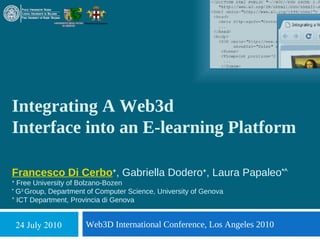
Integrating A Web3d Interface into an E-learning Platform
- 1. 1 Integrating A Web3d Interface into an E-learning Platform Francesco Di Cerbo+, Gabriella Dodero+, Laura Papaleo*^ + Free University of Bolzano-Bozen * G3 Group, Department of Computer Science, University of Genova ^ ICT Department, Provincia di Genova 24 July 2010 Web3D International Conference, Los Angeles 2010
- 2. Outline 2 Introduction The DIEL e-learning platform Our approach Web3D interface for DIEL Examples, results Concluding remarks 24 July 2010
- 3. Introduction 3 The Web has grown, allowing richer and interactive content Web technologies are becoming more stimulating ➢ collaborative spaces. Web-based knowledge transfer is becoming important We foresee a research trend in studying and designing e- learning collaborative systems where interactions among users can be done in a 3D environment, as a game-like immersive virtual reality. 24 July 2010
- 4. What we have done 4 Present our interactive e-learning platform DIEL developed as an extension to Moodle Focus the attention on the design, development and implementation of an innovative 3D client interface which uses the X3D standard in combination with WebGL and X3DOM 24 July 2010
- 5. Related Work 5 A number of studies has been focusing on effectiveness and benefits brought in e-learning by the use of metaverses, especially with Second Life. [Abbatista et al. 2009, De Lucia et al. 2008, 2009, Sancho et al. 2008]. In those works, a positive tendency emerges, especially for substituting direct face-to-face communications. Previous works using different technologies [e.g. Pfister et al. 1998] focus on virtual learning spaces, that ease the fruition of contents, providing ➢ representational and mnemonic method on mapping semantic onto spatial relations. 24 July 2010
- 6. Authoring &Visualizing Web3D 6 Content Several technologies exist to create 3D content for the web. Most of them are plug-in based systems This adds more complexity for the end user O3D: a Google attempt to establish an open standard for 3D graphics on the web. X3D: open ISO standard for creating specifications for representing 3D graphics WebGL: a new cross-platform, royalty-free web standard for a low- level 3D graphics API X3DOM: an open-source framework developed with the aim to bring the X3D standard to HTML5 on top of WebGL. 24 July 2010
- 7. The DIEL e-learning platform 7 DIEL is an e-learning platform developed for providing new ways of user interactivity and data representation WEB3D INTERFACE … in a web-based real-time environment 2D INTERFACE Extension of Moodle Use of the social translucence concept DIEL Virtual learning space Components: Rooms, Doors, users, resources MOODLE 24 July 2010
- 8. The Social Translucence Concept 8 How would you open this door, if you are in a hurry? 24 July 2010
- 9. The Social Translucence Concept 9 If we know that someone is on the other side, very carefully! Social translucence is a set of principle and design guidelines for designing social applications. 24 July 2010
- 10. The Social Translucence Concept 10 Three main properties: visibility: make socially significant information visible; awareness: visibility supports social awareness; accountability: individuals are socially accountable for their actions. DIEL design approach: mimetic: application represents social cues from the physical world, as literally as possible, in the digital domain. 24 July 2010
- 11. Previous DIEL 2D and 3D 11 Interfaces Interactions: via chat Visible: students, tutors door Resources Ffilmation (Adobe) Prototype tested Visible: the same items as in 2D 24 July 2010
- 12. DIEL In Action 12 Course conceptual representation (left) and DIEL implementation (right): 3 main topics analyzed with 4 common activities. 24 July 2010
- 13. Web3D Interface for DIEL 13 Technologies used: X3D, WebGL and X3DOM for HTML5 Designed and developed to ensure: Portability Extensibility License Simplicity of use 24 July 2010
- 14. Web3D Interface: Foundation 14 Framework developed as an AJAX based web application using the Closure JavaScript library [Google] modular and object-oriented Responsible for handling basic operations Everything related to 3D is handled by the X3D standard. Architecture: three main layers Client Communication User interface. 24 July 2010
- 15. Web3D Interface: X3D scene 15 modeling X3D scenes can be modeled using the XML syntax Scenes are generated dynamically at client side, according to the directives specified by the DIEL server and conveyed with specific The Web3D Interface with a single room (floor) integrated into Moodle. JSON messages Room: X3D scene representing a Floor Users: X3D scene representing Avatars Two predefined different avatars 24 July 2010
- 16. Concluding Remarks 16 We presented a Web3D interface for supporting interactions in social constructivistic learning communities of students and teachers, inside a web- based e-learning environment. The interface is very flexible and extensible. has been developed using X3D, WebGL and X3DOM, among the most promising technologies in Web3D. 24 July 2010
- 17. Future works 17 Improve the interface functionalities: Avatar personalization, more sophisticated environments, more descriptive objects for the resources, and so on… Embed videos directly in the 3D interface, in panels or surfaces, exploiting HTML5 & X3Dom library such a functionality would be important to implement user video chats Encode teachers’ knowledge (learning paths) into an ontological schema, supporting knowledge sharing on the web Analyze patterns in the usage of the virtual environment, with Social Network Analysis techniques, to evaluate and assess interactions quality from an educational point of view 24 July 2010
- 18. Acknowledgements 18 X3DOM project WEB3D community 24 July 2010
- 19. Thanks for the attention 19 WE ARE LOOKING FOR PARTNERS! Contacts: For: E-learning, Social Transulence, DIEL Dr. Francesco Di Cerbo, francesco.dicerbo@unibz.it For: 3D graphics, Semantics and Knowledge formalization Eng. Laura Papaleo, papaleo@disi.unige.it Coming soon: AGPL release @ http://diel.case.unibz.it This work has been partially supported by FP6 QUALIPSO project (IST- FP6-IP-034763), founded by the European Commission, and by a grant from University of Genoa CARED research centre. 24 July 2010
